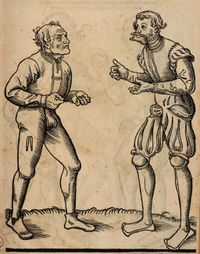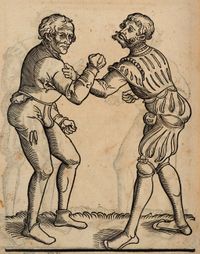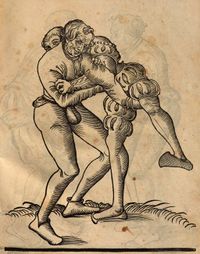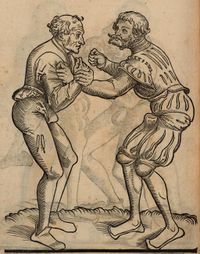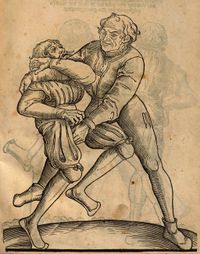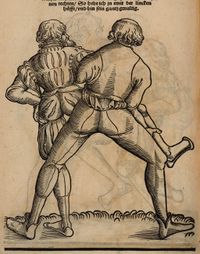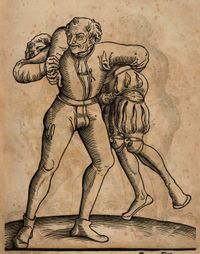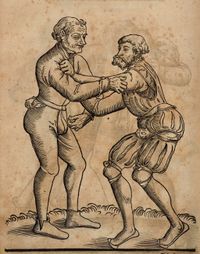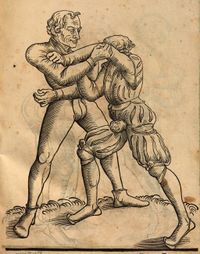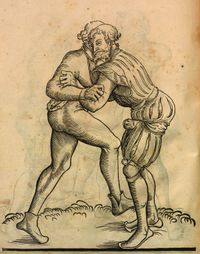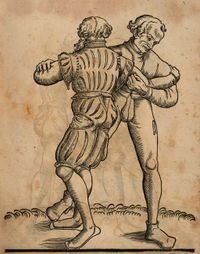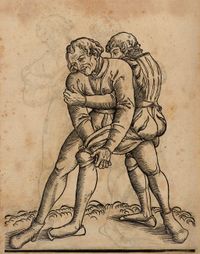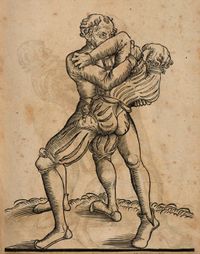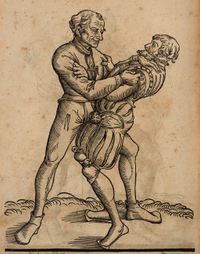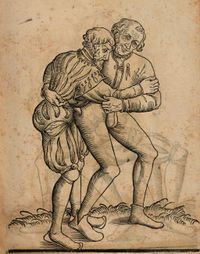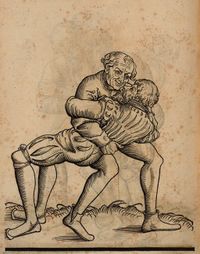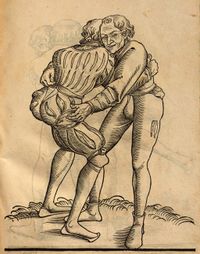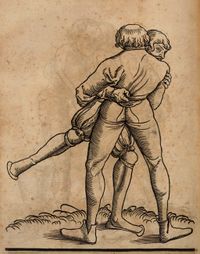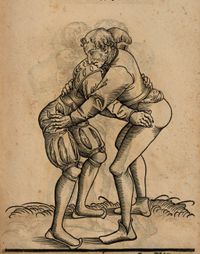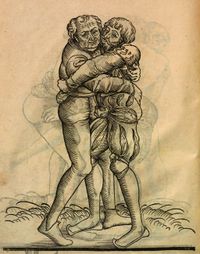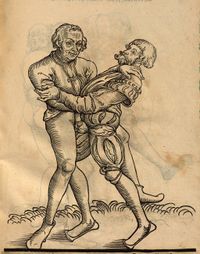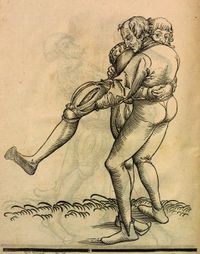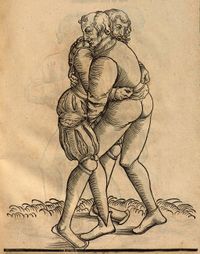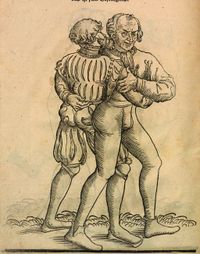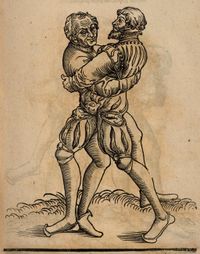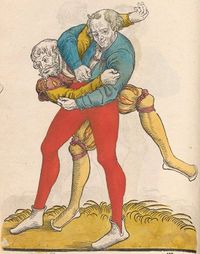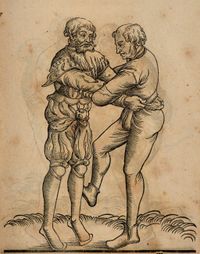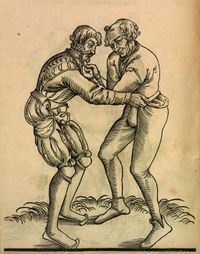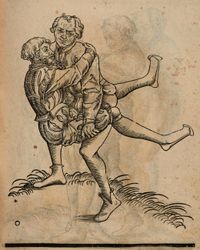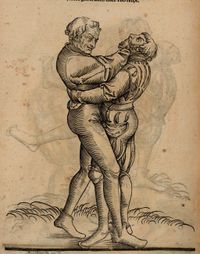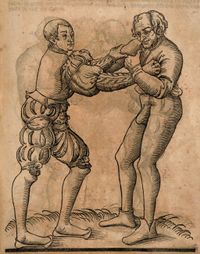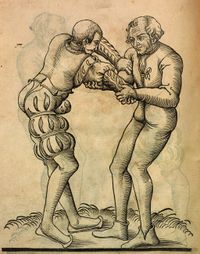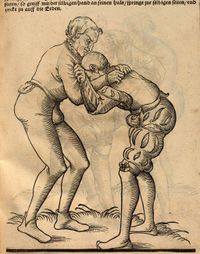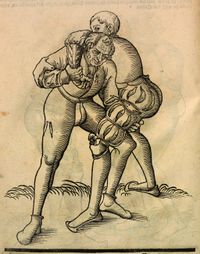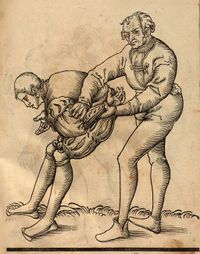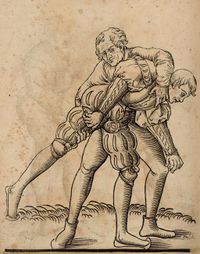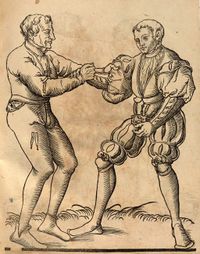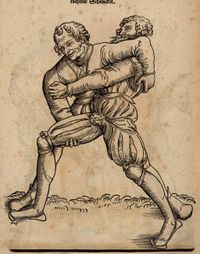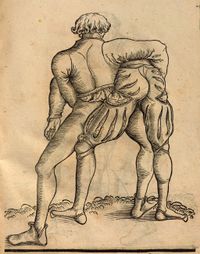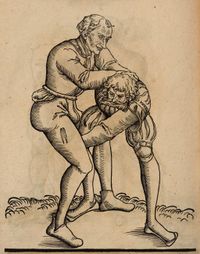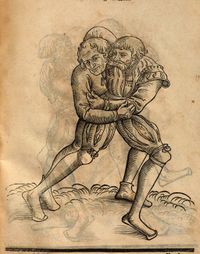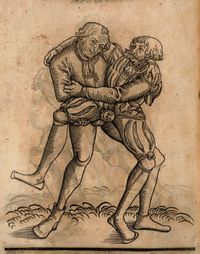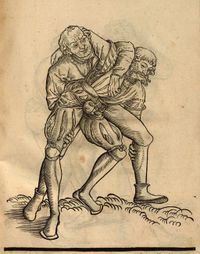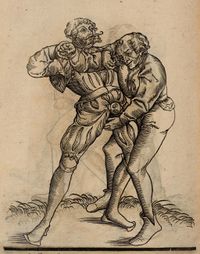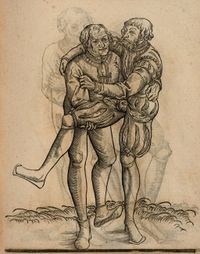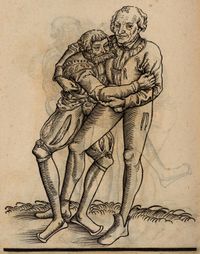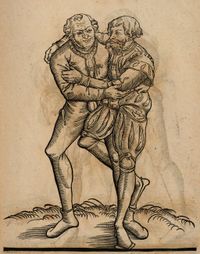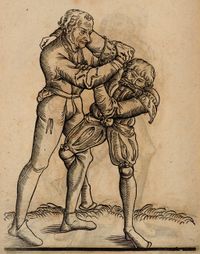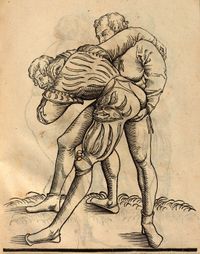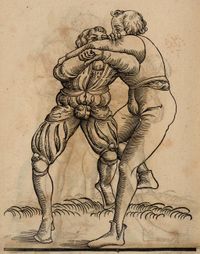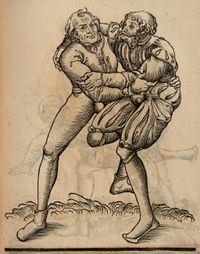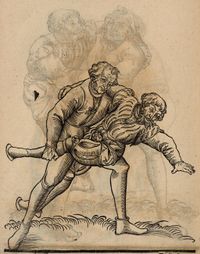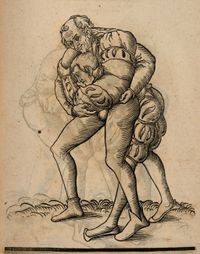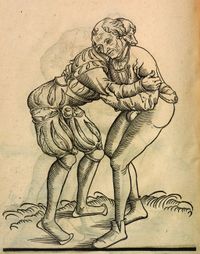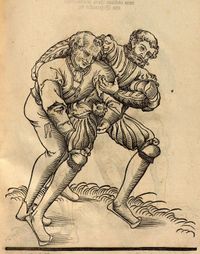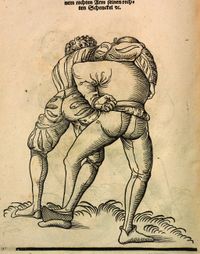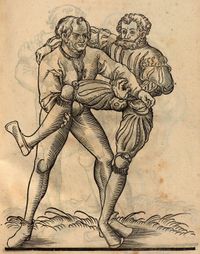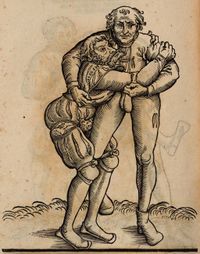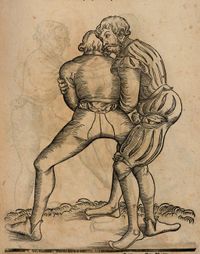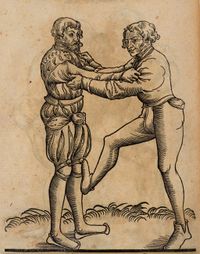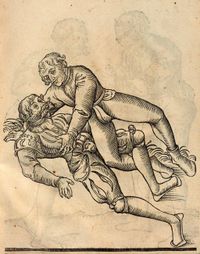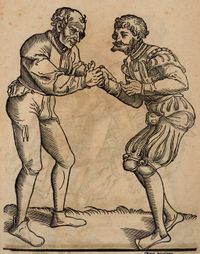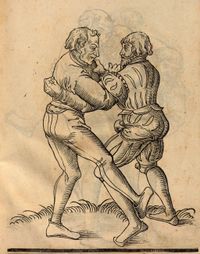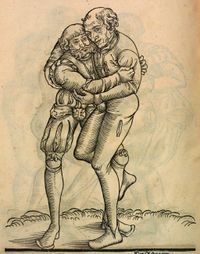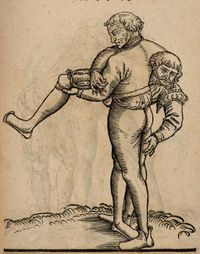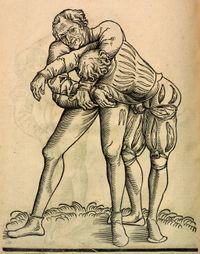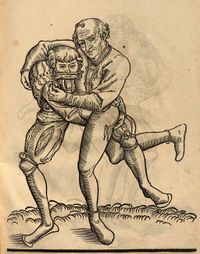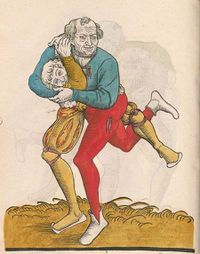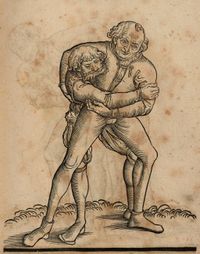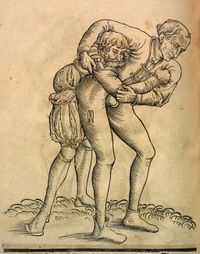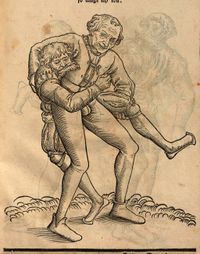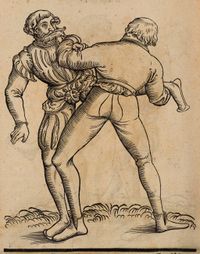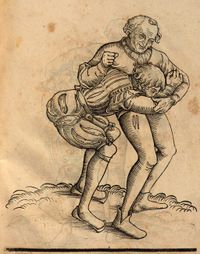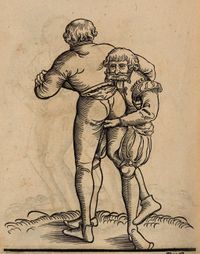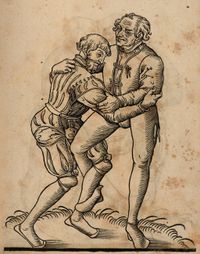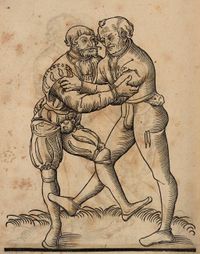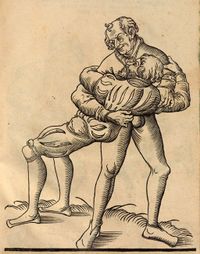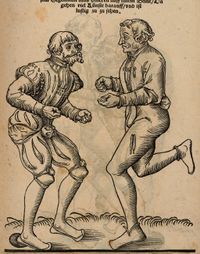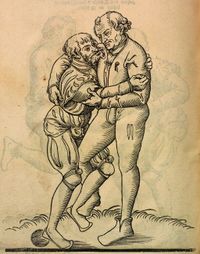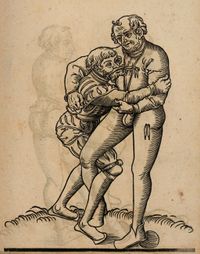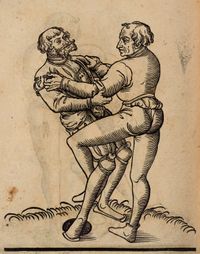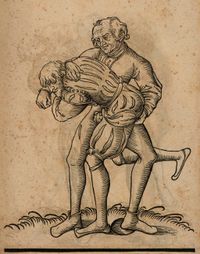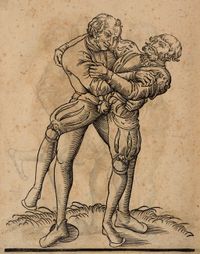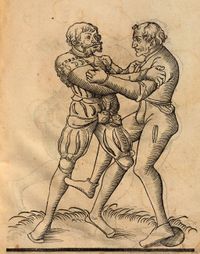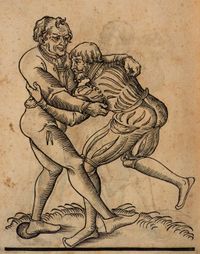|
|
You are not currently logged in. Are you accessing the unsecure (http) portal? Click here to switch to the secure portal. |
Difference between revisions of "Fabian von Auerswald"
| Line 26: | Line 26: | ||
| movement = | | movement = | ||
| notableworks = ''[[Ringer Kunst (Fabian von Auerswald)|Ringer Kunst]]'' (1539) | | notableworks = ''[[Ringer Kunst (Fabian von Auerswald)|Ringer Kunst]]'' (1539) | ||
| − | | manuscript(s) = [[Ringer Kunst (2º | + | | manuscript(s) = [[Ringer Kunst (2º Col.MS.Philos.62)|2° Col. MS Philos. 62]] <br/>(ca. 1539) |
| principal manuscript(s)= | | principal manuscript(s)= | ||
| first printed edition= | | first printed edition= | ||
| Line 42: | Line 42: | ||
| below = | | below = | ||
}} | }} | ||
| − | '''Fabian von Auerswald''' (1462 - after 1537) was a [[century::16th century]] [[nationality::German]] wrestling master. He served as wrestling master to | + | '''Fabian von Auerswald''' (1462 - after 1537) was a 15th-[[century::16th century]] [[nationality::German]] wrestling master. He served as wrestling master to John Frederick, Duke of Saxony, and mentions in his introduction that he instructed the children of the Elector and of members of the court in wrestling. |
| + | |||
| + | In 1537, Auerswald completed an extensive treatise on [[grappling]], which was later illustrated by [[Lucas Cranach the Elder]] and published posthumously in 1539 by [[Hans Lufft]] under the title ''[[Ringer Kunst (Fabian von Auerswald)|Ringer kunst: funf und Achtzig Stücke]]'' ("The Art of Wrestling: Eighty-Five Devices"). One of the earliest printed treatises on wrestling, the book includes lucid descriptions and detailed illustrations of all of its 85 devices, including one of only two known descriptions of the game called "wrstling in the pit". This treatise saw relatively wide circulation, and at least one wrestling master went as far as to commission a careful manuscript copy ([[Ringer Kunst (2º Col.MS.Philos.62)|2º Col.MS.Philos.62]])), to which he added his own annotations on many of the techniques. Auerswald's work also formed the foundation for [[Paulus Hector Mair]]'s treatment of the subject in his own compilation fencing manuscripts of the 1540s. | ||
== Treatise == | == Treatise == | ||
| Line 55: | Line 57: | ||
! <p>{{rating|B|Completed Translation (Archetype)}}<br/>by [[James Klock]]</p> | ! <p>{{rating|B|Completed Translation (Archetype)}}<br/>by [[James Klock]]</p> | ||
! <p>[[Ringer Kunst (Fabian von Auerswald)|Archetype Transcription]] (1539)<br/>by [[Keith P. Myers]]</p> | ! <p>[[Ringer Kunst (Fabian von Auerswald)|Archetype Transcription]] (1539)<br/>by [[Keith P. Myers]]</p> | ||
| − | ! <p>[[Ringer Kunst (2º | + | ! <p>[[Ringer Kunst (2º Col.MS.Philos.62)|Göttingen Transcription]] (after 1539)<br/></p> |
|- | |- | ||
| Line 314: | Line 316: | ||
! <p>{{rating|B|Completed Translation (Archetype)}}<br/>by [[James Klock]]</p> | ! <p>{{rating|B|Completed Translation (Archetype)}}<br/>by [[James Klock]]</p> | ||
! <p>[[Ringer Kunst (Fabian von Auerswald)|Archetype Transcription]] (1539)<br/>by [[Ingulf Kohlweiss]]</p> | ! <p>[[Ringer Kunst (Fabian von Auerswald)|Archetype Transcription]] (1539)<br/>by [[Ingulf Kohlweiss]]</p> | ||
| − | ! <p>[[Ringer Kunst (2º | + | ! <p>[[Ringer Kunst (2º Col.MS.Philos.62)|Göttingen Transcription]] (after 1539)<br/></p> |
|- | |- | ||
| Line 671: | Line 673: | ||
! <p>{{rating|B|Completed Translation (Archetype)}}<br/>by [[James Klock]]</p> | ! <p>{{rating|B|Completed Translation (Archetype)}}<br/>by [[James Klock]]</p> | ||
! <p>[[Ringer Kunst (Fabian von Auerswald)|Archetype Transcription]] (1539)<br/>by [[Ingulf Kohlweiss]]</p> | ! <p>[[Ringer Kunst (Fabian von Auerswald)|Archetype Transcription]] (1539)<br/>by [[Ingulf Kohlweiss]]</p> | ||
| − | ! <p>[[Ringer Kunst (2º | + | ! <p>[[Ringer Kunst (2º Col.MS.Philos.62)|Göttingen Transcription]] (after 1539)<br/></p> |
|- | |- | ||
| [[File:Auerswald 84.jpg|200px|center]] | | [[File:Auerswald 84.jpg|200px|center]] | ||
| Line 765: | Line 767: | ||
}} | }} | ||
{{sourcebox | {{sourcebox | ||
| − | | work = [[Ringer Kunst (2º | + | | work = [[Ringer Kunst (2º Col.MS.Philos.62)|Göttingen Transcription]] |
| authors = | | authors = | ||
| source link = | | source link = | ||
Revision as of 13:10, 23 November 2016
| Fabian von Auerswald | |
|---|---|
| 200px | |
| Born | 1462 |
| Died | ca. 1537 |
| Occupation | Wrestling master |
| Patron | John Frederick zu Saxony |
| Genres | Wrestling manual |
| Language | Early New High German |
| Notable work(s) | Ringer Kunst (1539) |
| Manuscript(s) | 2° Col. MS Philos. 62 (ca. 1539) |
| Concordance by | Michael Chidester |
Fabian von Auerswald (1462 - after 1537) was a 15th-16th century German wrestling master. He served as wrestling master to John Frederick, Duke of Saxony, and mentions in his introduction that he instructed the children of the Elector and of members of the court in wrestling.
In 1537, Auerswald completed an extensive treatise on grappling, which was later illustrated by Lucas Cranach the Elder and published posthumously in 1539 by Hans Lufft under the title Ringer kunst: funf und Achtzig Stücke ("The Art of Wrestling: Eighty-Five Devices"). One of the earliest printed treatises on wrestling, the book includes lucid descriptions and detailed illustrations of all of its 85 devices, including one of only two known descriptions of the game called "wrstling in the pit". This treatise saw relatively wide circulation, and at least one wrestling master went as far as to commission a careful manuscript copy (2º Col.MS.Philos.62)), to which he added his own annotations on many of the techniques. Auerswald's work also formed the foundation for Paulus Hector Mair's treatment of the subject in his own compilation fencing manuscripts of the 1540s.
Contents
Treatise
Images |
Archetype Transcription (1539) |
Göttingen Transcription (after 1539) | |
|---|---|---|---|
| Forward.
In hope that it should please / the honor of the illuminated and highborn sovereign and lord / Lord John Frederick / Elector of Saxony / my gracious Lord / have I, Fabian von Auerswald / taken upon myself / the honorable and noble art / and the knightly virtue of wrestling / which I have, by the authority / of the wise and illuminated, highborn sovereign and lord / Lord Ernest / Elector of Saxony / blessed and Christian in his thought such as from the same widely-famed wrestling masters / as have instructed the Elector and the young men / of my gracious Lords / the Electors' sons / and other sovereigns Counts and Lords / who have from those noble men and myself learned. And I have, in the same knightly and noble art / instructed / and drawn together, and in an artful and systematic report / and text / brought into print which is also the righteous art of wrestling / and previously the figure of it never came. / Which high report I also beg my gracious sovereign and lord with God's help I have been bestowed / and from which many honorable and good people may profit / honorably and with piety / to honorable and knightly causes it will be brought to light. And it is my hope / my humble and friendly prayer that when / any so high or low in station / should my work and labor / encounter or acquire / That he would take from me the same gracious friendship and aid / and keep myself and my children in his aid / Now that I am old man well beyond my days/ For I was born in 1462 / And have this work in the Year of Our Lord 1537, in Wittenberg, completed. The greatest companion is good balance, |
|||
| Firstly, see if your opponent comes at you high or low. If he is high, you need not worry about him, and do whatever devices you may have in mind. However, if he comes at you low, then beware. | Erstlich so sihe auff, ob der Man hoch oder nidrig zu dir gehet, Gehet er hoch, so darffstu dich nichts besorgen, und magst die stucke, so du im sinn hast, frey nemen, Gehet er aber nidrig, so habe dein inn guter acht. | Erstlich so siehe auf, ob der Man hoch oder niedrig zue dir gehet, Gehet er hoch, so darffstu in dich nichts besorgen, und machst die stucke, so du im sin hast, frey nehmen. Gehet er aber niedrig, so habe dein in guter achtt. | |
| The first is that one makes a short wind-off before the hand, left and right. Thereby you see how the opponent will respond to a hold. | Das erste ist, das man einem kurzt fur der Hand abwindet, linck und recht, Daraus sihet man, wie sich der Man gegen einem halten wil. | Das erste ist, das man einem kurzt fur der Handt abwindet, linck und recht, Daraus siehet man, wie sich der man gegen einem halten will.
Von dem Andbindenn In diesem stande kan man gar eigentlich sehen was den Autor fur vorteill gebe [aucht?], alß nemblich das er zwey gelenck, kegen des andern eine gelenck alß kegen das erste gelengk hinder das andern Handt seinen Ellebogen setzet da er dan viel stercker mit wegk nehmen kan, alse ihme der [?]theill mit seinem ersten gelengk das arms mit dem Handt [?]orn respondiren. Vors ander sehet er noch gar niedrig vnd nicht mit ausgestrackten gliedern damit ihn der so kegen ihm sehet, [?] in einer Schreche oder junctura ergreiffen kan. Zum dritten hat er seine hende noch gar dichte zuesamen und verschlossen, damit ihn sein keger, theil, nicht irgend bey einem finger oder daumen ergreiffen kan vnd ihn darnach also zue sich ziehen vnd zue bodem werffen welches auch sonderlich wol sol gerne [?] wenden. | |
| The second technique of lock-wrestling.
Here I bring my left arm over his left from behind, and heave his left leg up from the inside over the knee, and step with my left leg behind his right. The grip and the step must be done in one motion, and also done quickly. And this goes on both sides. |
Das Ander stucke des Schlosringens
Da falle ich mit meinem lincken Arm uber seinen lincken hinuber und hebe von inwendig sein lincke Bein uber dem Knie auf, und trete mit meinem lincken Schenckell hinter seinen rechten, Da mus das uberfallen und trit ein ding sein, so schnel mus er zugehen. Und das gehet von beiden seittenn. |
Von dem Schlosringen
Diß wiederresten geschicht wen sie beide einand[er] an die achselgreiffen, der eine unrendig der ander auserendig des arms, ist ober zum meisten am gewichte gelegen, welches der Autor mit seinem lincken Knie anzeiget vnd des kegenteils Schenckels hinter dem knie seidlinges wech weget, und zuegleich auch mit seiner lincken handt, des andern lincke bein in die hohe habet und ihn also [g?] den s[?]lle[?], Des mus aber alles geschehen, wen man sich bei den armen und schenckeln faßet zuerkerehe man sich bei dem ganzen leib erwischet aber angreifft, Ich solte es aber fur gewigster und Saifere an, bloßen zufulbie in gen also wen Ich mit baiden Armen kurtz vor seinen henden abwindet, und greiffe darnach mit meinem lincken Arm uber seine Achsel an seinen hals darnnach mit meiner rechten an sein gemechte zwischen die knie mit meinen linckern knie hinter sein rechte, trege am knie, drucke an halse, und hebe am gemechte [?] er sich mir [gent?] hin lincken winden, oder [?] also mir allein zue erden und solches geschicht auch auf beider seiten zur lincken, und rechten. Das Ander stucke des Schlossringens Da falle ich mit meinen lincken Arm uber seinen lincken hinuber und hebe von innwendig sein lincke Bein uber dem Knie auff, und trette mit meinem lincken schenckel hinder seinen rechten, Da mus das uberfallen und trit ein ding sein, so schnel mus er zugehen. Und das gehet von beiden seiten. | |
| This piece is called the weak point of the arms, and means that you strike with your right hand on his left near the fist, so that he must bend down. | Dis stucke heisset die schweche des Arms, das du mit deiner rechten Hand schlahest uber seine lincke, nahe bey der faust, so mus er sich biegen. | [F°7vr] Dis stucke heißet die schweche des Arms, das due mit deiner rechten Handt schlahest uber seine lincke, nahe bey der faust, so mus er sich biegen.
[F°8r] Von der Schweche des Arms In dieser figura meldet den Autor der Schweche des Arms welches sonderlich wol zue mercken ist, nicht allein ein Arm sondern in allen juncturis soll solches gebrauchet werden, Sonderlich an Starcken fersohnen den man sonst nicht abgewinnen kam Da mus man allezeit die Stercke kegen ihre Schweche setzen, alß wan Ich drey teile meiner [klingen?] Regen eines andern eine deil seiner Kling[en] setze[n] [...] | |
| When you see that he is bending down, then take hold of his left hand with your left and tug him. Thereafter, stretch out through with your right hand under his chin and while stretching you must step with your right leg behin his left leg, then you have total power over him. | Wenn du nu sihest, das er sich beuget, so nim mit deiner lincken Hand seine lincke und zucke in, Damach strecke deine rechte Hand unter seinem Kinn hindurch und Im strecken, mustu mit deinem rechten Bein hinder seinen lincken schenckel springen, so bistu seiner gantz gewaltig. | ||
| The tugging of the opponent.
When I have wound him off, then I come with my right hand on his right hand and with my left hand on his right elbow and tug him over before me/ And during that tug I reach through and grab with my left hand under his right arm over his chest. And while tugging / I step my left leg behind his right Then I heave him up with my left hip / and I have full power over him. |
Das zucken vor dem Man
Wenn ich im abgewinden habe, so kome ich mit meiner rechten Hand an seine rechte Hand, und mit meiner lincken Hand an seinen rechten Elnbogen, und zucke in fur mir uber, und im zucken, wisch ich mit meiner lincken Hand unter seinem rechten Arm hindurch, uber seine Brust, und im zucken, tret ich mit meinem lincken Schenckel hinter seinen rechten, So hebe ich in mit der lincken huffe, und bin sein gantz gewaltig. |
||
| Running through under the arm.
In the assault I catch his left hand with my right and lift it up, and run through under his left arm with my head and body, and step my left leg towards his right leg and straighten myself up, then I have him overpowered on my left hip. |
Das durchlauffen unter dem Arm
Im angreiffen erwische ich im seine lincke hand mit meiner rechten, und zucke dir ubersich, und lauf mit dem Kopff und leibe unter seinem lincken arm hindurch, und tret mit meinem lincken schenckel nach seinem rechten bein, und richt mich auff, so hab ich in auff meiner lincken huffe gewaltiglich. |
||
| Winding over the arm with one hand
This is only a figure or note about winding over the arm from which in the next device comes. |
Das abwinden uber den Arm mit einer Hand
Dis ist alleine eine figur oder vezeichung des abwindens uber den Arm, daraus nachfolgendes stucke gehet. |
||
| I put my left hand on his right arm and with my right hand I grab him | Ich setze meine lincke Hand auff seinen rechten Arm, und mit meiner rechten Hand erwische ich in. | ||
| Wheeling the opponent
Here I step with my right leg as wide as I can toward his right leg. |
Das Radt vor dem Manne
Alhie trette ich mit meinem rechten Schenckel als weit ich kan, nach seinem rechten Schenckel. |
||
| The Ladder
Thereafter I run with my left leg behind towards him. this is called the bustard, and if I step out of the balance, this is called the wheel before the opponent. |
Der Trapp
Darnach spring ich mit meinem lincken schennkel hinach, so heisst es der Trapp, und gebe mich aus meiner wage, so heisst es da Radt vor dem Manne |
||
| Lock-wrestling
Then I come over his left arm with my left arm, and step with my left leg behind his right heel and pull him over my right knee. This can be done left or right. |
Das Schlosringen
Da fall ich mit meinem lincken arm uber seinen lincken arm und trette mit meinen lincken Beine hinter seine rechte ferse und ziehe in uber mein recht Knie, Das man linck und recht nemen. |
||
| This is the winning step.
then I step with my right leg close into his right. Thereafter compose yourself as shown in the following figure. |
Das ist der gewinliche trit.
Da trette ich mit meinem rechten schenckel schlim zu seinem rechten, Darnach halt dich, wie folgende figur anzeiget. |
||
| Step with the left leg behind his right leg and put your left hand under his chin and stretch it out, thereby you turn him onto his back and the winning step is completed. | Trit mit dem lincken schenckel hinder sein recht bein und kom Im mit deiner lincken hand unter sein Kin und strecke in da selbst, so gewinstu Im den rucken an, also wird der gewinliche trit volkomen. | ||
| While winding in, I step with my right leg onto the inside his left leg and do the half-hip | Im einwinden springe ich mit meinem rechten schenckel an sein lincke Bein innwendig und neme die halbe Huffe. | ||
| When I have done the half-hip, and done it just a little, then I step out with my right leg entirely, yet I remain with my left hand on his shoulder and pull him entirely over. | Wenn ich die halbe Huffe genomen habt, und in ein wenig auffbracht, so trette ich mit meinem rechten Schenckel folt hinaus, so bin ich mit meiner lincken hand an seiner rechten Achsel und ziehe in volkomlich heruber. | ||
| Here you come to the little wheel by the opponent where one arm is over and the other underneath. My right arm must be underneath and my left above, and I press my left hand onto his upper right leg. | Also kompt man zum Redlin bey dem Man, Das ein Arm oben ist des ander unten, mein rechter Arm mus unten sein und mein lincker oben, und stemme meine lincke Hand an seinen rechten schenckel oben. | ||
| Thereafter I must step with my left leg inside his right foot and let my left hand glide down onto his buttock and turn him round to the right side. That is the little wheel by the opponent. | Darnach mus ich mit meinem lincken Beine treten innwendig an seinen rechten fuss und las meine lincke hand gleitenan seinen rechten Arsbacken und drehe in auff die rechte seiten umher. Das ist das Redlein bey dem Man. | ||
| When I place my push hand on his right leg, then he should respond by placing his right hand on my left thigh. Then I must use my left hand / to pull away his right hand. And as I do so, / I step forward, so that I come to the previous devices that serve the little wheel and the sweep out. | Wenn ich meine lincke Hand stemme an seinen rechten Schenckel, so setze er widerumb seiner rechte Hand an meinen lincken schenckel. So mus ich mit meiner lincken Hand im seine rechte Hand ausreissen und im ausreissen, trete ich hinein, so kom ich zu den vorigen stucken, die da zu dem Redlin und dem ausschlagen dienen. | ||
| This is the winning step by the opponent. Here must also one arm be underneath, and the the other above, and my right arm underneath, then I step the winning step with my right leg between his legs, and with the left behind his right. | Ist der gewinliche trit bey dem Man. Da mus auch ein Arm unten sein, der ander oben, und mein rechter Arm unten, so trette ich mit meinem rechten Schenckel zwischen seine Beine gewinlich und mit dem lincken hinder seinen rechten. | ||
| When I have stepped the winning step and have come behind his right with my left leg, then he bends down, and I put my left hand onto his throat, and then he is powerless against me. | Wenn ich nu den gewinlichen trit getreten habe, und mit meinem lincken schenckel hinder seinen rechten komen bin, so bewget er, so kom ich als denn mit meiner lincken Hand an seinen Hals, so ist er gantz unmechtig mein. | ||
| What I lift up I lay down.
This device I do thus: There must be one arm on top, and the other must be underheath, and when he wants press me onto himself, then I step out with my right leg behind his left, and lift up high with my left arm from the inside to his right leg, and bend a little backwards, then I have full power over him. |
Was ich heb das leg ich.
Das stuck nem ich also, Es mus ein Arm oben, der ander unten sein, und wenn er mich wil zu sich drucken, so trete ich mit meinem rechten Bein naus hinder sein linckes, und hebe mit meinem lincken Arm von innwendig zu seinen rechten Schenckel inn die hohe, und gebe mich ein wenig uber ruck, so bin ich seiner gantz geweltig. |
||
| Benedict's technique
Here again must one arm be above, and the other underneath, and I press hard forward with my chin beside his neck. And when I notice that he bends down, then I put my left arm / between his legs and pull him to me / I push him away with my chin above, and then I have him however I want him. |
Das Benedicts Stucke
Alhie mus auch ein Arm oben, der ander unten sein, und drucke ich hart mit meinem Kin neben seinen Hals nein, und wenn ich mercke das er bewget, so kome ich mit meinem lincken Arm zwischen seine Beine, und ziehe In zu mir, Dringe In oben mit dem Kin von mir, so habe ich in wie ich wil. |
||
| the two hips
These are the two hips / where again one arm is above, and the other underneath. Then I step out with my right leg over his right leg and use the hip and pull him over it. (If I) Do not let him fall, then his right leg comes before my right, and I then step with back with my left leg, then he throws me over also. It is gentlemanly of him. |
Die zwo huffe
Dis sind die zwo Huffe, das auch ein Arm oben der ander unten ist, Darnach tret ich mit meinem rechten schenckel uber sein recht Bein naus, und neme die Huffe und zihe in heruber, Las in nicht fallen, so kompt sein rechtes bein fur mein rechtes, und trit mit seinem lincken schenckel hintersich, so ziehet er mich auch heruber, das ist sein Geselliglich. |
||
| The following figure applies to the next. | Die nachfolgende figure, gehort zu der nehesten vorgehenden. | ||
| The elbow hip.
When someone grabs the front of my doublet, then I sweep him hard with my elbow on his fist and I stoop down low in the balance / so that my elbow pulls his fist away, the I straighten myself up, follow after with my right hand, step out with my right leg and use the right hip, which goes forcefully. |
Die Huffe des Elnbogens
Wenn mich einer vorn ins Wammess fast, so wisch ich mit meinem Elnbogen hart an seine faust und geb mich nider inn die wage, so reis ich mit meinem Elnbogen seine faust heraus und gebe mich auff, folge mit meiner rechten Hand nach, trete mit meinem rechten schenckel naus und neme die rechten Huffe, die gehet gewaltiglich. |
||
| When someone wants to grab hold of me, I put both arms over his arms and gather them underneath, and heave him up by the arms, and with my right right foot I sweep his left, and he falls over. | Wenn mich einer fassen wil, so kom ich mit beiden Armen uber seine Arm unten zu hauff und hebe in also mit den Armen auff und schlahe mit meinem rechten schenckel an seinen lincken, so fellt er so fiel ehe. | ||
| When someone grabs me the front of my doublet with both hands, I reach with both of my elbows between his arms and I sink down low in the balance. That way I pull both his arms away. | Wenn mich einer mit beiden Henden vorn inn mein wammess hat gefast, so fare ich mit meinen beiden Elnbogen zwischen seinen Arm und gebe mich nieder inn die wage, so reis ich im beide Arm aus. | ||
| This piece is called breaking in with both elbows
When I have pulled away both his arms, then I have both of my arms undereath. I then grab hold of both of his legs with my arms and lift him onto me and push my knees apart, I bring both his legs over my knee. |
Das stucke heisst das einbrechen mit den beiden Elnbogen
Wenn ich einem beide Arm ausgerissen habe, so habe ich beide meine Arm unten, so erwisch ich mit meinen armen seine beide Bein und hebe in zu mir und gehe mit meinen Knien von einander, so bringe ich seine beine uber mein knie. |
||
| The Dung hoe
When someone has both arms under and presses me to himself with power then I place my right hand under his chin and push him away from me. And in pushing through I step with my right leg into the back of his left knee. This piece also goes left and right. |
Der Misthack
Wenn einer beide Arm unten hat und druckt mich mit gewalt zu sich, so kom ich mit meiner rechten Hand unter sein Kin und dringe in von mir, und im dringen, kome ich mit meinem rechten Bein hinder sein linckes inn die Kniekele. Das stucke gehet auch linck und recht. |
Images |
Archetype Transcription (1539) |
Göttingen Transcription (after 1539) | |
|---|---|---|---|
| I place my left hand on this right as close as I can. From here comes the following piece | [31] Die lincke Hand setze ich auff seine rechte / so nahe ich kan / Daraus gehet nachfolgendes Stück. | ||
| Then I grip under his right elbow with my left arm and pull him to me / then he begins to bend, and when he bends / then I slip my left hand to his right fist. Then comes a horrific wrenching of the arm that is woeful that hurts a lot. This is for rough people and is not gentlemanly. | [32] Als denn greiff ich mit meinem lincken Arm unter seinen rechten Elnbogen / und ziehe in zu mir / so begint er zu biegen / wenn er beuget so las ich meine lincke Hand gleiten inn sein rechte Faust / Draus gehet ein scheuslich Armrencken / welchs fast wehe thut / Das gehört fur grobe Leute und ist nicht Geselliglich. | ||
| When someone drives his head into my chest / and you cannot dislodge him because his force is unusually strong / This is a sign that he cannot nor will do anything / but he will only keep up his push / then one must make sure / that he gets both hands on his collar above on his neck / and step back in the balance and tug / so that he falls to his knees / But if he is not wearing a doublet / then you must take care / that you get both of your arms on his neck / and close them tightly together, / springing back in the balance / so that it is as one / But if he sets his head on of your sides / then grip his throat with the same hand / spring to the same side and pull him to the ground. | [33] Wenn einer mit dem Kopff einem an die brust kompt / und kan sein nicht ledig werden / sondern er boret hart zu einem / Das ist ein zeichen das er nichts kan / oder nemen wil / allein er wil sich sein auff[ss?]halten/So mus einer trachten/das er im mit beiden henden inn sein Koller oben an seinen hals kompt / und mus inn der wage zu rück springen und mit zucken / so felt er auff die knie / Hat er aber kein Wammes an / so mustu acht haben / das du beide hende oben an seinen hals kriegest / und schleus[f?]t die fest zusamen / spring inn der wage zu rück / so ist es gleich eins / Setzet er aber den kopff dir auff ein seiten / so greiff mit der selbigen hand an seinen hals springe zur selbigen seiten / und zucke in auff die Erden. | Wen einer mit dem Kopf einem an die brust kompt, und kan sein nicht ledig werden, sondern er boret hart zue einem, das ist ein zeichen das er nichts kan oder nemen wil allein er wil sich sein aufhalten, So mus einer trachten, das er ihm mit beiden henden in sein Koller oben an seinen hals kompt, und mus in der wage zu rück springen und mit zucken so felt er auf die knie hat er aber kein Wammes an, so mustu acht haben das du beide hende oben an seinen halß kriegest und schleust die fest zuesamen, spring in der wage zue rück so ist es gleich eins. Setzet er aber den kopf dir auf ein seiten, so greiff mit der selbigen hand an seinen hals, springe zur selbigen seiten, und rucke ihn auf die erdenn. | |
| Run-through under the arm
Here I grab hold of his left hand which push upwards and slip my head under his left arm and through, and step with my left leg between both his legs. Then my left hand comes between his legs and I straighten myself up and lift him up in the air. |
[34] Das durchlauffen unter dem Arm
/ Da neme ich seine lincke Hand / die rucke ich uber sich / und wisch mit meinem Kopff unter seinem lincken Arm hindurch / und trette mit meinem lincken Beine zwischen seine Beine / So kompt meine lincke Hand zwischen seine beine / und richte mich auff / hebt in inn alle höhe. |
||
| With my left hand I pull his left hand to me and reach in with my left hand under his right elbow. Thus he gives me his entire back. | [35] Mit meiner lincken Hand / zucke ich seine lincke Hand zu mir / und kom im mit meiner rechten Hand unter sein lincken Elnbogen / So gibt er mir gantz den Rücken. | ||
| I let my right hand reach through between his legs and stri him over his throat with my left hand and press him down low with the left hand heaving him with the right hand ut in the air. | [36] So las ich meine rechte Hand faren hinder zwischen seine Beine / Schlahe mit meiner lincken Hand uber seinen Hals / und druck in mit der lincken hand nider / Hebe in mit der rechten Hand inn alle höhe. | ||
| Here I must put my right hand on his right thumb, with the left hand behind his shoulder. Thus I bring him into the wheel. | [37] Da mus ich mit meiner rechten Hand komen an seinen rechten Dawmen / mit der lincken Hand kom ich im hinden an sein Schultern / So bringe ich in inn das Radt. | ||
| When he steps with the right leg then I step with the left behind his right and reach through with my left hand under his right breast, and thus I get his right leg with my right hand. | [38] Ein Bruch uber das Radt
Wenn er mit dem rechten Schenckel springet / so spring ich mit dem lincken hinder seinen rechten / und fahr mit meiner lincken Hand unter seiner rechten Brust hindurch / so krieg ich mit meiner rechten Hand seinen rechten Schenckel. |
||
| A break of the lock-wrestling
When he grabs hold of me with his right hand then I use the left hip. This can be done left or right. |
[39] Ein Bruch auff das Schlosringen
Wenn er mir mit der rechten Hand hinüber fellt / so neme ich die lincke Hüffe / Das nimpt man recht oder linck. |
||
| Another break against lockwrestling
When he grabs hold of me with his right arm over his left, then I reach over on his neck with my left arm and step forward with my left leg and use the left hip which goes completely freely. |
[40] Ein ander Bruch uber das Schlosringen.
Wenn er mir mit seinem rechten Arm felt uber seinen lincken / so falle ich mit meinem lincken Arm an seinen Hals / und springe mit meinem lincken Schenckel hinein / und neme die lincke Hüffe / die gehet gantz frey. |
||
| Break against the short hip
When he steps in with his right leg and does the half hip then his foot comes outside my right foot. Then I fall with my right knee onto the back of his right knee and press down into the balance, and thus he is brought to his knees. |
[41] Bruch uber die kurtze Hüff
Wenn er mit seinem rechten Schenckel erausser trit / und nimpt die kurtze Hüffe / so kompt sein Fuss auswendig an meinen rechten Fuss / So falle ich mit meinem rechten Knie inn seine rechte Knie kele / und druck nider inn der Wage / so kompt er nider auff die Knie. |
||
| Break against the high hip
Just when he runs in then I put my left hand on his left shoulder. With it, I pull him over backwards and grab him by his right leg, and heave him up high into the air. |
[42] Bruch auf die hoh Hüff
Bald wenn er hinein springt / so kompt meine lincke Hand auff seine lincke Achsel / Dieselbe ziehe ich im uber rück / und ergreiffe in bey seinem rechten Schenckel / So hebe ich in inn alle höhe. |
||
| Break of the struck out hip
When he steps out with the hip then I put my left arm over his right shoulder and onto his neck and press him onto me with my left hand. Thereafter I reach with my right hand and grab him on the outside of his right leg and heave him up to the left side. Then I have subdued him. |
[43] Bruch auff die ausschlagende Hüff
Wenn er mit der Hüffe rausser springet / so kome ich mit meinem lincken Arm uber seine rechte Achsel an seinen Hals / und dringe in mit me[in]er lincken hand von mir / Darnach greiffe ich mit meiner rechten Hand auswendig an seinen rechten Schenckel / und heb in auff nach der lincken seiten / So bin ich seiner gar mechtig. |
||
| The counter to the tug in front of the opponent
When he tugs at me with the left arm outwards, then I step out with my left leg behind his right and with my left elbow I force him over backwards and catch him between his legs with my right arm. This piece goes left and right. [Note: the woodcut shows the technique with the sides reversed] |
[44] Bruch auff das zucken vor dem Man.
Wenn mich einer zucket mit dem lincken Arm hinnaus / so trete ich mit meinem lincken Beine hinder sein rechtes hinaus / und dringe in mit meinem lincken Elnbogen uberrucken aus / und erhasche in mit meinem rechten Arm zwischen seine Beine / Das stücke gehet linck und recht |
||
| Break of the leg hook that is called "the head first topple"
When someone has me in a leg hook then I strike out his right leg with my left leg and grab him by it with my right arm, Lift him up, and then I have all power over him. |
[45] Bruch auff den Haken das Ausschüpffen genant.
Wenn mir einer ein Haken stehet / so schlahe ich mit meinem lincken Schenckel seinen rechten Schenckel aus / und erwisch im den selbigen mit meinem rechten Arm / Hebe in auff / so bin ich seiner geweltiglich. |
||
| This is a break against the break of the head first topple
That when he would use the head first topple on me then I use the bar. That is a good aid at least. |
[46] Dis ist ein Bruch uber den Bruch des Ausschüpffens / als wenn er mich ausschüpffen wil / so neme ich den Riegel geschwinde / Der ist mir auffs wenigst ein guter behelff. | ||
| Another break of the leg hook
While entering, I sweep with my left leg on his left heel and pull him back with my left hand. Many do not see this technique coming. |
[47] Ein ander Bruch auff den Haken
Im einlauffen / schlahe ich mit meinem lincken Schenckel an seine lincke Ferse / und rucke in mit meiner lincken Hand zu rucke / Das stucke / können nicht viel begreiffen. |
||
| Another break of the leg hook
I put with both hands on his throat and press him in before me, that way he must give way. |
[48] Ein ander Bruch auff den Haken.
Ich kom im mit beiden Armen an seinen Hals / und dringe in von mir / so mus er weichen. |
||
| When I press him before me with both hands then I let my right hand lie on his neck and press him down with it. Thereafter, grab between his buttocks with my left hand and turn him around right over just as one would do the little wheel of the opponent. | [49] Wenn ich in mit beiden Armen von mir dringe / so las ich meine rechte Hand im an seinem Hals ligen / und drücke in damit nider / Greiff darnach mit meiner lincken Hand zwischen seine Arsbacken / und drehe in rechts rumher / wie man sonst das Redlein bey dem Man nimpt. | ||
| Break against the break of the entering hook
I stay under him in the balance / and with my right arm I strike his left arm out / and pretend to run for a leg hook / but I stay standing with my legs. Thereby I learn / if he knows how to break the entering leg hook / If he does, then he will do it / and then I place my right hand over his chest and force him backwards over my right knee / but if he does not know then I do the leg hook with his help. |
[50] Bruch uber Bruch des Hakens einlauff
Ich bleib unten inn der wage stehen / und schlahe mit meinem rechten Arm seinen lincken aus / und thu gleich / als wolt ich im inn Haken lauffen / und bleibe mit meinen Beinen stehen / Daraus lerne ich / ob er den bruch des einlauffs des Haken kan / Kan er in / so kompt er selbst / so kom ich mit meinem rechten uber sein brust / und dring in uber mein rechte Knie uberruck / kan er in aber nicht / so nem ich den haken mit sein gehülffen. |
||
| A Break against the leg hook and bar
When he has run into a leg hook on me then I stretch my left leg / so that he must take the bar. Whether he stays in the bar or steps into a leg hook, I then step well with my left leg out behind him, and stoop down completely in the balance and grab his left leg with my right hand above his ankle / then he has no more power. |
[51] Ein Bruch uber den Haken und Riegel
Wenn er mir inn Haken gelauffen ist / so streck ich mein linck bein / so mus er inn Riegel / Er bleibt nu im Riegel oder lauff mir inn Haken / so trette ich mit meinem lincken Schenckel wol hinder in hinaus / und gebe mich gantz nider inn die wage / und greiff mit meiner rechten hand nach seinem lincken bein / uber seinen knöchel / so hat er keinen behelff mehr. |
||
| Break against the bar in the leg hook
When he stands in a leg hook on me and I have stretched my left leg so that he grabs me by the bar and as he grabs me, then immediately I step out with my left leg, out and behind him, and quickly stoop down low into the balance. That way his bar is countered. |
[52] Bruch uber den Riegel im Haken
Wenn er mir im Haken stehet / und ich meinen lincken Schenckel strecke so wischet er mir inn Riegel / und im neinwischen / als bald bege ich mich mit meinem lincken Schenckel hinter in hinaus / und gebe mich gechling nider inn die wage / so ist im der Riegel zubrochen. |
||
| The left hip serves as a counter to the entry into the leg hook. | [53] Die lincke Hüffe dienet wider den einlauff des Hakens. | ||
| This is winding into the wheel
Here I must wind off my right hand over his left arm, and onto his body. |
[54] Dis ist das einwinden zum Radt /
Da mus ich mit meiner rechten Hand uber seinen lincken Arm abwinden zu seinem Leibe. |
||
| This is the break before the run in hip
That is what this piece is called. Have good caution with it and it is called "the left arm bar". If he would make an entry of the hip, see to it, that you do the bar with the left arm under and through his left arm and get down quickly in the balance on the left side. |
[55] Das ist der Bruch vor die einlauffen Hüff.
Das stück heisst / hab gut achtung drauff / und heisst der Riegel des lincken Arms. Wil er ein einlauffen der Huffe nemen / Sihe darauff / dastu mit dem lincken Arm den Riegel nimpst / unter seinen rechten Arm hindurch / und setze dich bald inn die wage auff die lincken Seiten. |
||
| And if he has already come to the leg hook / then beware and turn your right foot with the toes outward so that he cannot do to the short hip. After that he must do the high or struck out hip. Close your left hand/ and set it hard on his side under and through his left arm and stoop down into the balance on the left side and grab his right leg with your right arm, etc. | [56] Und ob er mi.[r] schon inn Haken kompt / so hab achtung drauff / und wende deinen rechten Fuss mit der Zehe hinauswertz / so kan er zur kurtzen Huffe nicht komen / Als denn mus die hohe oder die anschlage Huffe genomen werden / so thue deine lincke Hand zu / und setzs im hart an seine seiten / unter seinen rechten Arm hindurch / und gib dich auff die lincke seiten inn die wage / und erwische mit deinem rechten Arm seinen rechten Schenckel etc. | ||
| And step with your left leg on the outside of on his left heel, then heave his right leg up with your right hand, and with your left hand push him over backwards, so that he cannot get away with his left leg, and that way he falls over backwards etc. | [57] und trit mit deinem lincken Bein an seine lincke Fersen auswendig / so hebstu mit der rechten Hand seinen rechten Schenckel auff und dringst mit der lincken Hand uber ruck / so kan er mit dem lincken Bein nicht hinweg komen / so fellt er uber rucke etc. | ||
| The entering of the leg hook
I strike his left hand out with my right hand in and grab him over the shoulder and run in with my right leg on his right leg then I am right in the leg hook. |
[58] Der einlauff des Hakens
Ich schlahe in mit meiner rechten Hand seinen lincken Arm aus / und kom im uber die Achsel / und lauffe im mit meinem rechten Schenckel an sein rechte Bein / so bin ich im recht im Haken. |
||
| Lockwrestling from which comes an armbreak
When I put my left arm over his left arm then I must place my arm high between his legs, when I push up his left arm, it must break or he will fall. |
[59] Das Schlosringen / daraus ein Armbruch gehet.
Wenn ich mit meinem lincken Arm uber seinen lincken Arm kome / so mus ich mit meinem Arm hoch zwischen seine Beine komen / so strecke ich im seinen lincken Arm ubersich / so mus er brechen / oder fallen. |
||
| A legbreak
When he stands with straight legs then I thrust my right leg onto his left kneecap(?). But if he stands with a correct balance then I cannot do this. |
[60] Ein Beinbruch
Wenn er stehet mit gestrackten Beinen / so stoss ich mit meinem rechten Beine auff sein lincke Knieschling / Stehet er aber recht inn der wage / so kans nicht sein. |
||
| The turn in of the hips and the leg hook
From it goes the backward throw: when I take hold of someone by the arms, then I go with my right arm over and turn in my right hip quickly, and step into the leg hook and stay with my left foot against him, that way the backwards throw will go fast and well. |
[61] Die einwindung der Hüffen des Hakens
Daraus gehet der hinderwurff / wenn ich einem inn die Arm gehe / so behalt ich meinen rechten Arm oben / und wende meine rechte Huffe gehling / nein / und lauff im inn Haken / und bleibe mit meinem lincken Fuss gegen im stehen / So gehet der hinderwurff schnell und wol. |
||
| If he comes at you with his hands open, then you will use the hand breaking technique. If he gives you the right hand then you give him the left. If he gives you the left then give him the right. And always with your thumb in the middle of his hand as you see here. | [62] Gehet er mit auffgethanen Henden zu dir / so nim das Stücke des Faustbrechens also / Gibt er dir die rechte Hand / so gib im die lincke / Gibt er dir die lincke / so gib im die rechte / Und allweg deinen Dawmen im mitten inn seine hand / Wie du denn sihest. | ||
| From this technique comes an armbreak
Here I come with my right arm over his left arm, from a wind outside in behind his left elbow. And if the arm does not break. Then I sweep out his left with my right leg. |
[63] Aus diesem stucke gehet ein Armbruch / Da kom ich mit meinem rechten Arm uber seinen lincken Arm von innwendig heraus / hinder seinem lincken Elnbogen / Und ob der Armbruch nicht gieng / So schlahe ich mit meinem rechten Schenckel an seinen lincken. | ||
| Backward throw from the hook
When I am in the hook then I turn my left foot in towards him. Here the leg hook and the hips must be firm into him. Then I lean backwards, and do a powerful backward throw. |
[64] Der hinderwurff des Hakens
Wenn ich inn dem Haken bin / so wende ich den lincken Fuss hinein zu im / Da mus der Hake und die Huffe fest anstehen / als denn geb ich mich hindersich auff / und neme den hinderwurff gewaltiglich. |
||
| The slant
From the outside leg hook goes the slant thusly. If he is to heavy for me in the leg hook, then I grab his right leg with my left arm and heave it up. Thereafter I step with my right leg behind his left. Then I have full power over him. |
[65] Der Schragen
Aus dem ewser[?] Haken gehet der Schragen / also / Wenn er mir zu schweer ist im Haken / so greiff ich mit meinem lincken Arm an seinen rechten Schnenckel / und hebe den auff / Darnach trette ich mit meinem rechten Schenckel hinder seinen lincken / So bin ich sein gantz mechtig. |
||
| When he has stretched me out of the hook then I come over both of his arms with my left arm and do the same as I would to take the slant and thereby I take the left hip. | [66] Wenn er mich hat aus dem Haken gestrackt / so kom ich mit meinem lincken Arm uber seine beide Arm / und thue gleich / wie ich den Schragen nemen wolt / und neme die lincke Huffe dafür. | ||
| The fork in the hook
With my right thigh, I go high, as high as I can and turn around to the left with my body stay up with my leg high in the air then I fall over on top of him. |
[67] Die Gabel im Haken
Mit meinem rechten Schenckel gehee ich auff so hoch ich kan / und wende mich mit meinem Leibe lincks rumher / bleibe oben mit meinem Schenckel stetigs inn der hohe / so fallte ich oben auff in nider. |
||
| When someone falls upon me with both hands at my throat. Then I grab his neck and arm together rise up and take the fork as well. | [68] Wenn mir einer mit beiden Armen uber meinen Hals fiel / so neme ich im Hals und Arm zu hauff / gehe auff / und neme auch die Gabel. | ||
| The short hip
When he stretches his foot out of the hook towards me, then I step with my right leg outside by his right foot, and stretch my thigh. |
[69] Die kurtze Huffe
Wenn er mir den Fuss aus dem Haken streckt / so trette ich mit meinem rechten Schenckel an seinen rechten Fuss auswendig / und strecke meinen Schenckel. |
||
| The high hip
When I am in the hook and my opponent stands with his feet too wide apart. Then I step in front of him with both of my legs and as I step, step down low in the balance and straighten myself up behind, thereafter I to pull him up and over forcefully. |
[70] Die hohe Hüffe
Wenn ich im Haken bin / und der gegenteil stehet mir weit / So springe ich mit beiden Beinen fur in / und begebe mich inn sprung inn der wage nider / und richt mich hinden auff / darnach ziehe ich in oben gewaltiglich rüber. |
||
| The struck out hip
When I am in a hook with someone and he stands too wide against me so that I cannot take the other hip. Then I step out of the hook with my right leg and turn out entirely with my hip grab his left leg with my left arm and run with him to the left / as far as I wish. |
[71] Die ausschlahende Hüffe
Wenn ich einem im Haken bin / und er stehet mir zu weit / das ich der anderen Hüffe keine nemen kan / So springe ich mit meinem rechten Schenckel im aus dem Haken / und wende mich mit meiner Huffe gantz hinaus / greiffe mit meinem lincken Arm an sein linck Bein / und lauffe mit im lincks rumher / so lange ich wil. |
||
| Thereafter I let my right hand go off his head and with it I grab his left leg up from below. Thus I make him into a sackpipe. | [72] Darnach las ich im mit meiner rechten Hand den Kopff gehen / und ergreiff mit der selbigen sein linck Bein von unten auff / Daraus mache ich in zur Sackpfeiffen. | ||
| This technique is called the back break
When someone would press me onto him and I cannot take the hip then I step out of the hook with my right leg as wide as I can and press into the middle of his back with my right elbow so that he must fall under me. This is friendly. |
[73] Das stück heisst den Rücken knicken
Wenn mich einer von im dringen wil / das ich keine Hüffe nemen kan / so trette ich mit meinem rechten Schenckel im aus dem Haken / als weit ich kan / und druck mit meinem rechten Elnbogen im mitten inn sein rucken / das er unter mir mus danider fallen / Das ist Geselliglich. |
||
| This is the outer hook.
When we sweeps under my right arm with his head. Then I take the backward throw as I also would in the right hook. |
[74] Das ist der eusser Haken
Wenn er mir mit seinem Kopff unter meinem rechten Arm hindurch wischt / So neme ich den hinderwurff / wie sonst im rechten Haken. |
||
| This is the underhook that my right arm comes around his left. After this comes the backward throw. | [75] Das ist der unterhake / das mein rechter Arm umb seinen lincken kompt / Daraus gehet der hinderwurff. | ||
| Whoever has this done to him so that the backward throw is of no use, then I step with my right leg outside of his left and take the technique called the slant. That can be done as the backward throw. | [76] Wo einer dazu gedrungen würde / das der hinderwurff nicht diente / so trette ich mit meinem rechten Schenckel aussen an seinen lincken / und neme das stücke den Schragen genant / Der gehet zu heben wie der hinderwurff. | ||
| This is also a technique from the underhook that is called the half hip. | [77] Das gehet auch ein stücke aus dem untern Haken / das heisst die Halbe Hüffe. |
Images |
Archetype Transcription (1539) |
Göttingen Transcription (after 1539) | |
|---|---|---|---|
| Here you may see: how one would wrestle in the pit in the past.
One stands in the hole and may not remove his leg from it and his opponent must hop on one leg. Much art comes of this and it is funny to watch. |
[78] Hie sehet sich an: wie man vorzeiten im Grüblein gerungen hat.
Der inn der Gruben stehet / darff mit dem Beine nicht heraus / und sein Gegenman mus hincken auff einem Beine / Da gehen viel Künste darauss / und ist lustig zu zu sehen. |
||
| This is the backwards throw from the hook to throw him out from the hole. It goes quickly and is very funny. | [79] Das ist der hinterwurff des Hakens / einen aus der Grube zu werffen / Der gehet schnell und sein lustig | ||
| This is the hip and the back of the knee which is also good to throw someone out of the pit. Then I come with my right leg into the back of his knee and turn to my right side. | [80] Das ist die Hüffe der Kniekel / ist auch gut einen aus der Gruben zu werfen / So kome ich mit meinem rechten Schenckel inn seine rechte Kniekel / und wend mich auff die rechte seiten. | ||
| This is a technique to throw someone from the hole it is called the dung hoe. Here I come with my left leg into the back of his right knee and force him over backwards. | [81] Das ist ein stücke aus der Gruben zu werffen / das heisst der Misthacke / Da kome ich mit meinem lincken Beine inn seine rechte Kniekele / und dringe in uberrücke. | ||
| This is a free technique from standing in the pit
When he lets go of my leg hook, then I stoop through under his right arm with my head and my right arm above comes his neck and my left arm comes between his legs and then I run to the right with him and I stay the whole time with my left leg in the hole. |
[82] Das ist ein frey stücke inn der Gruben stet / wenn er mich inn den Haken wil[?] lassen / So wische ich mit meinem Kopff unter seinem rechten Arm hindurch / kompt mein rechter Arm oben an seinen Hals / und der lincke Arm kompt zwischen seine Beine / und lauff recht mit im rum / so bleibe ich mit dem lincken Schenckel allemal inn der Gruben. | ||
| The technique that belongs to the pit
When your opponent is about to take the hip. So I stand with my right leg high in the air against him. And I stay with my left leg in the hole in the balance, that is the counter. |
[83] Das stücke das inn die Gruben gehört /
Das widerteil das ein Hüffe nimpt / so fass ich mit meinem rechten Schenckel inn die höhe / im entgegen / so bleibe ich mit meinem lincken Schenckel inn der Gruben / inn der wage / ist der Bruch. |
||
| When he takes the dung hoe against me taking me on the inside with his left leg then I sweep with my right leg on the inside of his left, which is the break of the dung hoe. | [84] Wenn er den Misthaken nimpt gegen mir / nimpt er in mir mit dem lincken Schenckel / so schlahe ich in mit meinem rechten Schenckel an seinen lincken innwendig / ist der Bruch ubner den Misthaken. | ||
| Then I take the technique that pulls with my right leg. I sweep his left leg then he must go out of the dung hoe to the side, so that he must fall. | [85] So neme ich das stücke das anschlahens / mit meinem rechten Beine / Schlahe ich an sein linckes Bein / so mus er aus dem Misthaken gegen inn die Seiten / das er fallen muss. |
For further information, including transcription and translation notes, see the discussion page.
| Work | Author(s) | Source | License |
|---|---|---|---|
| Archetype Images | Lucas Cranach | Ringer Kunst | |
| Translation | James Klock | The Klocktower | |
| Archetype Transcription (1-35) | Keith P. Myers | Wiktenauer | |
| Archetype Transcription (36-91) | Ingulf Kohlweiss | Wiktenauer | |
| Göttingen Transcription |
Additional Resources
- Ott Jud; Dürer, Albrecht; Auerswald, Fabian von; Petter, Nicolaes; Paschen, Johann. Chronik alter Kampfkünste: Zeichnungen und Texte aus Schriften alter Meister entstanden 1443-1674. Weinmann, 2003. ISBN 978-3878920311
- Wassmannsdorff, Karl. Die Ringer-Kunst des Fabian von Auerswald. Leipzig: Priber, 1869.


